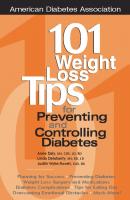101 Weight Loss Tips for Preventing and Controlling Diabetes. Anne Daly
Чтение книги онлайн.

Читать онлайн книгу 101 Weight Loss Tips for Preventing and Controlling Diabetes - Anne Daly страница 3
Название: 101 Weight Loss Tips for Preventing and Controlling Diabetes
Автор: Anne Daly
Издательство: Ingram
Жанр: Спорт, фитнес
Серия: 101 Tips Series
isbn: 9781580403948
isbn:
This BMI says that you meet the criteria for obesity, and you may have some serious health problems
| How does BMI relate to health risk? |
|
TIP:
The health problems that come along with obesity are coronary heart disease, stroke, high blood pressure, sleep apnea, diabetes, gout, high cholesterol, arthritis, and gallstones. All overweight and obese adults (ages 18 years or older) with a BMI of 25 or higher are at risk for developing these health problems. Those with a BMI of 30 or higher have serious health risks, especially for heart disease. When you lose weight, you improve your health in many ways!
Obese people may be limited in how agile they are, so they have a higher risk of having accidents. They may have difficulty getting pregnant and difficulties with pregnancy and delivery. You and your doctor should consider all of your health problems when choosing a weight loss program. NOTE: You are more likely to have health risks when your body fat is concentrated in your belly rather than in your hips. To check the location of your body fat use the waist-to-hip measurement (What is the waist-to-hip ratio?).
|
|
What is the waist-to-hip ratio? |
TIP:
The waist-to-hip ratio (WHR) is the comparison of your waist measurement to your hip measurement. It is a way to see whether your weight is primarily in your hips and buttocks (in what is known as a “pear” shape, common in females) or in the abdomen (making an “apple” shape, common in males). Measure your waist with a nonstretchable measuring tape at the smallest point (between the rib cage and navel), and measure your hips at the widest point (around the buttocks). A WHR of more than 1.0 in males and 0.8 in females suggests that you have increased health risks. As an example, a woman who weighs 300 lbs has a waist measuring 53 inches and hip measuring 60 inches.
The waist/hip ratio is 0.9.
The risk is higher for women with a waist measurement of 35 inches or more and higher for men with a waist measurement 40 inches or more.
| I tend to have a belly. Is being shaped like an apple bad? |
|
TIP:
Yes, because where your body stores fat makes a difference in your health. People who have a larger waist are more likely to develop heart disease, high blood pressure, and diabetes. Health risks seem to come with having a waist measurement of greater than 35 inches in women and greater than 40 inches in men. Abdominal fat is worse than fat on your buttocks or thighs, because that extra fat surrounds important organs such as the liver and pancreas. When you have fat in this area of the body, your body can’t use the insulin produced by your pancreas very well. This is called insulin resistance, and it causes high blood sugar levels. High blood sugar levels put your organs at higher risk.
If you lose weight, the amount of fat stored around your waist and important organs will decrease, and they will all work better.
|
|
Everybody in my family is heavy. How can I ever expect to be thin? |
TIP:
You may not ever be thin, but you can certainly lose weight and get fit. It may help to think of your family’s gift this way: you may have inherited genes that make you more energy efficient. People who survive a famine are likely to have a “thrifty gene” that allows them to get by on fewer calories. When the food supply is more plentiful, people who are more energy efficient gain weight.
The second thing you inherit from your family is your lifestyle. When the Pima Indians, who had low rates of obesity until 50 years ago, adopted the “Western” lifestyle, food was plentiful and they exercised less. They now have an epidemic of obesity and diabetes.
Families pass on habits that may lead to weight gain. Your parents played a strong role in the development of your food preferences, physical activity habits, and eating habits. But you can make new habits. And pass them on to your children, too.
|
|
Is one method of losing weight better than the other? |
TIP:
Yes, eating fewer calories than you burn is the key. There are a variety of weight loss therapies ranging from nutrition therapy (low-calorie diets and increasing physical activity) to behavior therapy, drugs, and surgery. But for the long run, it’s burning the calories you eat that counts. Recently, at the direction of NIH, the U.S. Department of Agriculture (USDA) completed a study on popular diets and found the diets that reduce calories result in weight loss. If you don’t exercise, eating approximately 1,400–1,500 calories a day is recommended, no matter which foods you eat.
It is also appears that the easiest way to control calories is by cutting back on how much fat you eat. Most people who succeed at weight loss and keep it off eat a diet with 20–30% of their calories from fat. This is significantly less fat than is in the average American diet, which is more than 36% calories from fat.
What you need to understand is that you don’t follow a diet for 8 days, 8 weeks, or 8 months. Your new eating habits are the basis of your everyday food choices for the rest of your life. Healthy meal plans are high in vegetables, fruits, and other carbohydrates such as whole grains and low-fat dairy products. This is a moderate-fat, СКАЧАТЬ